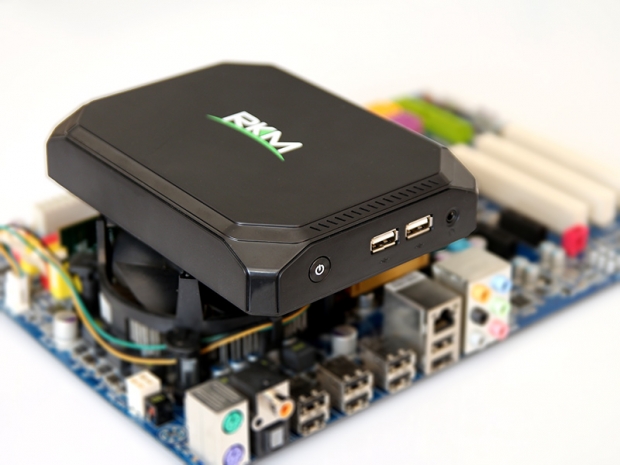Index
Rikomagic RKM M36 Specs and Performance
There is not much to say about the Intel Atom Z3736F processor, we’ve already reviewed a number of Bay Trail devices, and Intel’s 22nm entry-level processor has been around for a while.
Coupled with 2GB of RAM and speedy solid state storage, the processor is fast enough for most everyday tasks, such as content consumption and light office work. However, Rikomagic’s decision to go for a somewhat bigger chassis makes a difference, especially in sustained performance.
We will get to that later, after we take a look at the specs.
Rikomagic RKM M36 Specifications:
- Processor: Intel Atom Z3736F, quad-core, 1.33GHz stock, 2.16GHz Turbo, 22nm
- Graphics: Intel HD Graphics, 311MHz base, 646MHz burst
- RAM: 2GB DDR3L
- Storage: 32GB eMMC, expandable via microSD card up to 32GB
- Wireless: dual-band 802.11b/g/n, Bluetooth 4.0
- Dimensions: 158 x 120 x 33mm (6.21 x 4.72 x 1.30in)
- Weight: 300g
- Ports: 4 x USB 2.0, HDMI, 3.5mm audio, 100Mbps RJ45 (actually a USB to LAN adapter), DC in (12V 2A)
Since we are already very familiar with the platform, we saw no point in running too many benchmarks, so we focused on what really matters – storage and sustained performance. We threw in a few benchmarks pitting the tablet Bay Trail against AMD’s Athlon 5350 desktop APU, just to get a better feel of how they stack up.
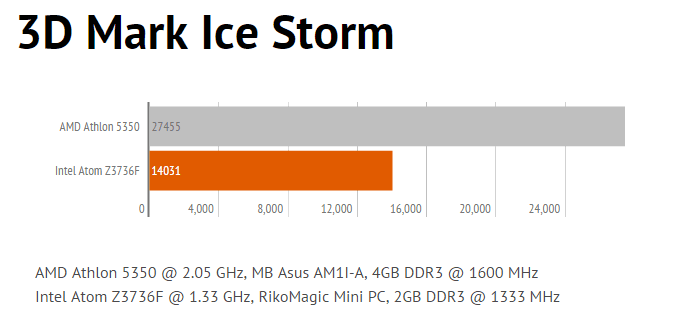
In 3D Mark Ice Storm, the RKM scores 14031, which is what we’ve come to expect from Bay Trail machines.

The bigger AMD APU also outpaces it in PCMark 8, which is hardly surprising considering the TDP difference.
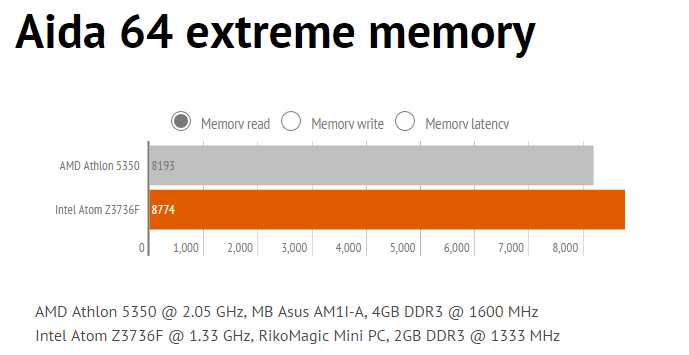
It’s not a one-sided match though, as Intel’s platform manages to score somewhat better in AIDA 64’s memory benchmarks.
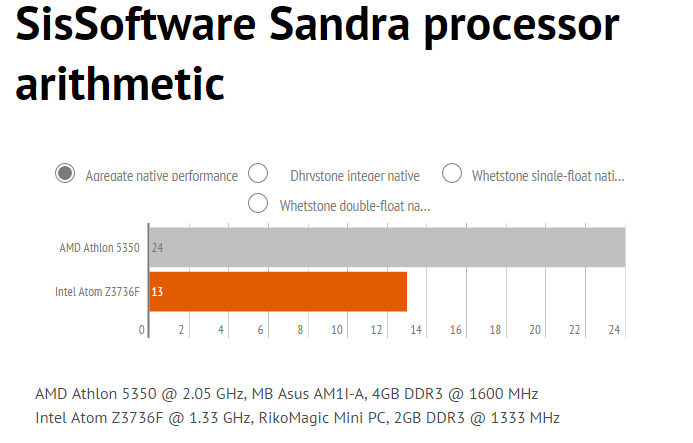
SiSoftware Sandra aggregate native performance also favours the AMD.
Bear in mind that this is really not a fair comparison – the AMD chip has a TDP of 25W, while the Atom has a TDP of about 5W and an SDP of 2.2W. It might not be fair, but that was sort of the point, as we wanted to compare the RKM M36 to an HTPC platform used by one of our teammates. At the end of the day, the tablet SoC comes very close to AMD's entry-level desktop offering in most tests. Of course, AMD has the upper hand in GPU-bound tests.
As we continued to run benchmarks, we got a feeling that the RKM M36 copes with load pretty well, quite a bit better than stick PCs and other micro PCs. The system can sustain Turbo clocks for a while, more than enough for everyday scenarios (unzipping, installing, browsing etc.).
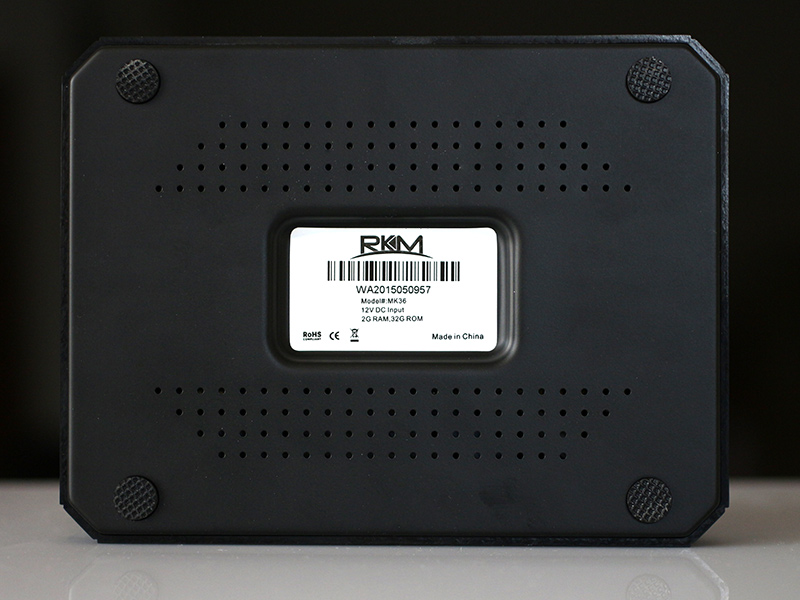
HWmonitor CPUID returned some weird numbers, including a faulty temperature reading and a max clock of 3284MHz (!?) at full load. However, PCMark was a bit more realistic (and reliable) – it showed the RKM hitting just over 2.2GHz after an hour of benchmarking. The CPU managed to sustain high clocks in a number of tests, namely casual gaming, write and photo editing tests.

The CPU quickly heats up to about 50 degrees Celsius under average load, but even if you push it very hard, it usually stays under the 70 degree mark at all times.
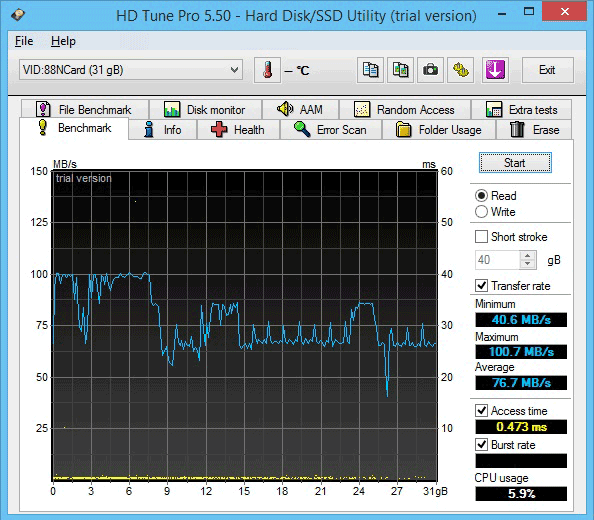
Storage tests reveal that the eMMC drive is a solid performer, scoring well over 100MB/s in a number of tests. Of course, sequential read and write are not nearly as fast, but we’ve come to expect that. The biggest problem with the storage has nothing to do with performance – it’s the fact that you get two operating systems on a 32GB drive, along with a number of partitions.
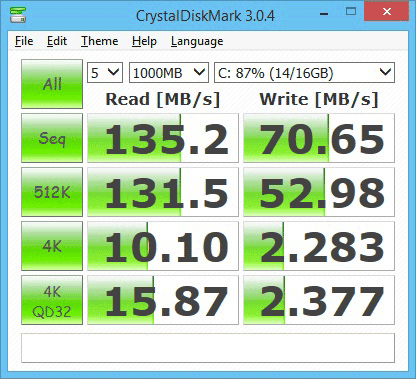
While having Android and Windows on a HTPC may sound appealing, especially if you are into casual gaming, 32GB is a bit too cramped. You also end up with loads of partitions, which is a hassle. Luckily, the microSD slot should be more than sufficient for the occasional download, although it won’t come near the eMMC in terms of sheer speed.

